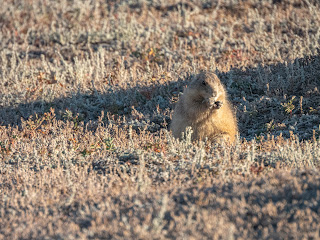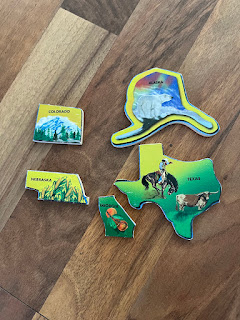Wednesday, October 16
We woke up today in Fargo! We hadn’t really made any plans for what to do here, so I did what I do and went in search on the internet for things to do in Fargo. Right away something popped up that looked interesting and unique and after reading the description to Kath we decided to go for it. It is a “Murder Mystery Detective Experience” call “Motive for Murder”. Sounds interesting, doesn't it? We thought so. You download an app on your phone which provides you with a map of locations where you go to gather clues as to who committed the murder. Two maps are provided: one for walking and one for driving. What a great way to get to know the town!! We opted for the walking option, even though it is supposed to be windy here today (which is quite common if you listen to the locals) with a high of 67, but the wind makes if feel about 10 degrees cooler. There is audio on the app, too, where I think clues are provided. It could end up being silly, but what the heck, it sounds like fun. We also decided to continue our tradition of doing an Escape Room on our trips and booked an Escape Room adventure, too! Gone are the days, it appears (probably because of COVID), where you join people you don’t know for an Escape Room. All of the rooms/bookings are private. The minimum number of people “required” for the one we chose, “Museum of Terror”, is three so, after Kathi called, we were told we could do it with two, but had to pay as if our party was three. We really love our escape rooms, so we went ahead and booked it. We’ll see how we do in solving both the murder mystery and the escape room.
Before leaving for the Escape Room we went out the back door of our Airbnb to the “Art and Learning” store that is just across a parking lot from us. Our Airbnb host owns the store and works there and it seemed like it would have been a shame not to go over and introduce ourselves. So we went and chatted with him for a bit and browsed the store which is an art supply store as well as what I think would best be described as a teacher resource store. Then it was near 1 o’clock and our escape room appointment was for 1:30 so we left and made our way to Puzzled Escape Rooms. The door was locked when we arrived so we had to ring the bell a couple of times before someone came and let us in. We were escorted into our room, where the woman told us the basic rules of an escape room as well as how to go about asking for clues. Once she left the room, the hunt was on for clues! Unfortunately, we once again, as so many times before, failed to solve all of the puzzles within the allotted one hour, but we were pretty darn close and we had a lot of fun trying. The goal was to figure out enough clues to find the keys to five locks to keep Dracula from coming back to life. We found four of them and were only a couple of clues away from finding the key for the final one. Considering the room was created to be challenging for larger groups, we are pretty dang proud of ourselves. I highly recommend trying an escape room if you have never done one. It is a great way to spend an hour and test your problem-solving skills.
Next on our agenda was the Murder Mystery Detective Experience!! First, however, we stopped at a nearby Starbucks for a quick pick-me-up, and we stopped at the house because I couldn’t remember if I had taken my morning meds and I wanted to check before we got any further into the day. Turned out I had, indeed, taken my meds so all was well. Next we stopped at the post office so I could mail out postcards to my grandkids. Kathi wanted to get a mailing envelope to mail the postcard and the car bingo card she got for her granddaughter, Amara. Once those tasks were accomplished, we mapped our way to the YMCA which was the starting point for our detective adventure.
This was fun although I think people around us must have wondered what in the heck we were doing. We followed a map to different locations around downtown Fargo where we would stop and listen to the recorded “interviews” with witnesses and suspects. We were also asked at each location to answer some question about the location. Questions about number of windows and doors or spotting certain characteristics of buildings that would help determine where the victim or the suspect was in “fuzzy” video obtained to help in the investigation. In all we walked about 2.5 miles around town and it took us a little over 2 1/2 hours to stop at all the locations and listen to all the interviews and in the end, we were SUCCESSFUL in identifying the murderer!! Kathi took selfies of us at each location to show that we truly were following all the clues. We were very proud of ourselves for solving the mystery.
Once back “home”, we did most of our packing since my train leaves at 4:13am and I need to be at the train station by 3:30 so I can check my bag. Crazy, right? My hope is to try and catch some sleep on the train once I board, but I didn’t have much luck sleeping on the way here, so I’m not really hopeful!! Kathi plans on coming back to the house because, heck, checkout time isn’t until 11am so she can take her time loading all her stuff into the car before starting the drive back to Indianapolis!
As always, we are sorry to see Girls Weekend come to an end but, as always, we had a wonderful time and feel blessed that we are able to take these getaways together and spend time in one another’s company. We always feel refreshed after these adventures.
Until next year, blessings to you all and do your best to enjoy every day.






































